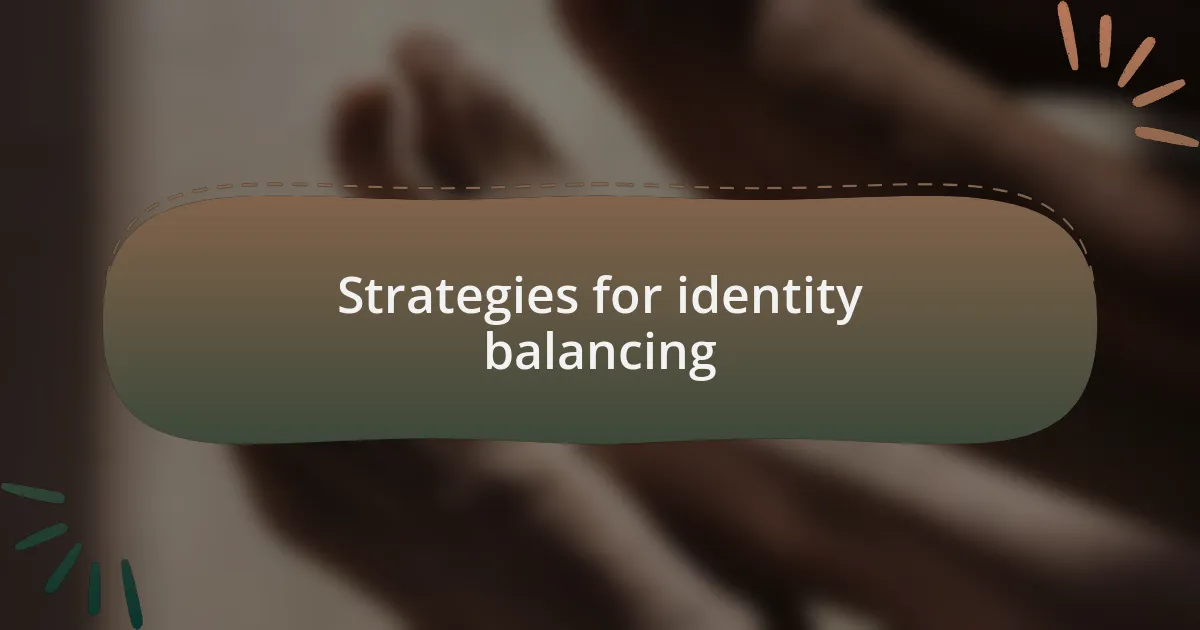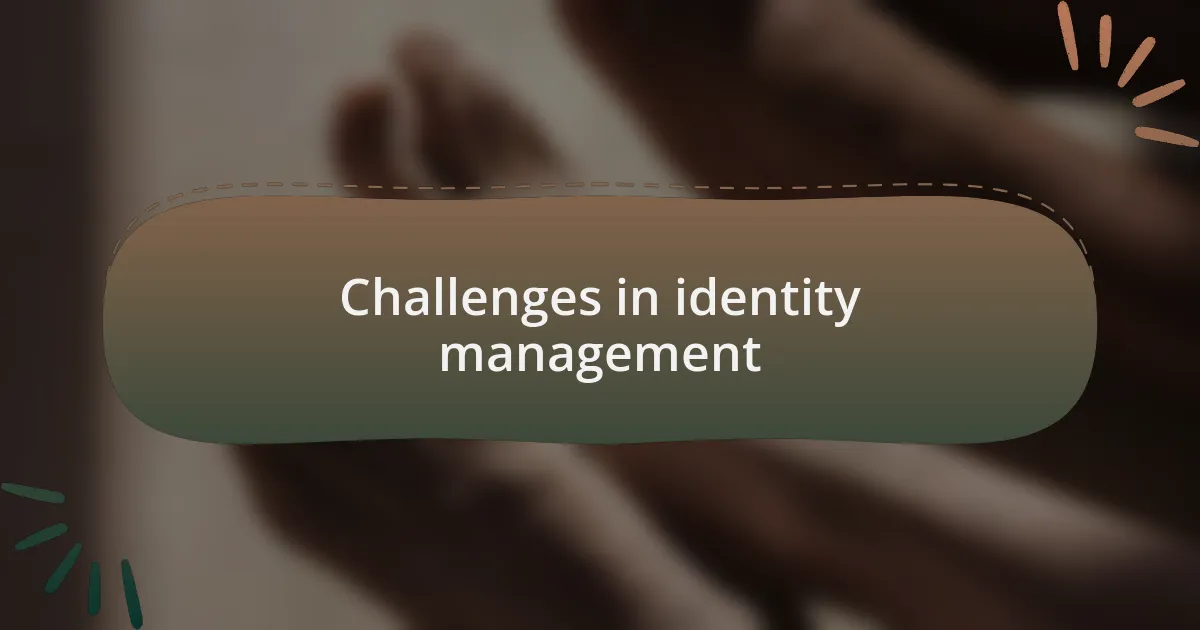Key takeaways:
- Gender equality advocacy requires challenging societal norms and systemic barriers while embracing diverse identities for true inclusivity.
- Recognizing and understanding the intersectionality of multiple identities fosters empathy and strengthens advocacy efforts.
- Effective advocacy involves active listening and collaboration, creating safe spaces for sharing personal stories to build deeper connections.
- Building supportive networks is essential, as they provide reciprocal support and foster solidarity among advocates from various backgrounds.

Understanding gender equality advocacy
Gender equality advocacy is about striving for a world where everyone, regardless of gender, has equal rights and opportunities. I remember a time at a community event when a young girl shared her aspirations to become an engineer, only to be met with skepticism from her peers. That moment cemented my belief in the necessity of advocacy; it’s not just about policies, but also challenging societal norms that shape our perceptions from such a young age.
At its core, gender equality advocacy goes beyond mere awareness; it’s about taking actionable steps to dismantle systemic barriers. Sometimes, I find myself reflecting on conversations with friends who express frustration over workplace inequities. Why do we still hear stories of women undervalued in roles they excel in? These conversations ignite a fire in me to push for change, demonstrating the critical need for inclusive spaces and fair representation in all sectors of society.
Embracing diverse identities in advocacy is essential, as each experience enriches the dialogue around gender equality. I once met an individual who identified as non-binary and shared their struggles in navigating societal expectations. It was a poignant reminder that advocacy must encompass all identities and experiences, as true equality means creating space for everyone to express their authentic selves without fear of judgment.

Importance of multiple identities
Recognizing the importance of multiple identities is crucial in the realm of gender equality advocacy. Each identity brings a unique perspective that shapes our understanding of discrimination and privilege. For instance, during a workshop I attended, a transgender activist shared their lived experience, highlighting how their identity intersected with societal biases. This opened my eyes to the complexity of gender issues and reinforced the idea that advocacy must be inclusive of all narratives.
When I consider my own journey as a woman of color, I often think back to moments where my background influenced my advocacy efforts. It can be challenging to navigate conversations about privilege, especially when my experiences differ vastly from others. I always ask myself: How can I effectively use my voice while amplifying those who are often unheard? It’s this thought process that has taught me the value of intersectionality—appreciating how various identities overlap and inform our fight for equality.
Moreover, understanding multiple identities fosters empathy and connection among advocates. I once worked alongside a group that included individuals from various backgrounds. The blend of stories and experiences deepened our collective mission, proving that when we unite diverse identities, we create a stronger, more resilient front. In times where voices may clash, I’ve learned that it’s the shared experiences that ultimately drive us toward a common goal. Isn’t it inspiring to think how our differences can lead to valuable insights and collaboration?

Strategies for identity balancing
Finding harmony among multiple identities can be challenging, but I’ve discovered that intentional reflection plays an essential role. For instance, I regularly set aside time to journal about my different roles, whether as an advocate, a friend, or a family member. This practice helps me identify where my values align and where they might conflict, enabling me to navigate complex social situations with greater clarity and purpose.
Another strategy I’ve found effective is cultivating a supportive community that celebrates diversity. I remember forming a small group with like-minded individuals who openly shared their experiences. By creating a safe space to discuss our multifaceted identities, we could not only support each other but also redefine our approaches to advocacy. It’s incredible how simply sharing our stories can illuminate common threads, allowing us to advocate more effectively together.
Finally, I prioritize open communication with others about my multiple identities. During a recent panel discussion, I openly shared the difficulties I face in balancing my roles, sparking candid conversations that resonated with many attendees. By being vulnerable, I encourage others to share their journeys as well, reinforcing the idea that we are all in this together. Have you ever noticed how vulnerability can foster deeper connections? It’s in that shared understanding where real progress happens.

Challenges in identity management
Managing multiple identities often feels like walking a tightrope. I recall a day when I confidently approached a work meeting, only to feel the weight of my community obligations pulling me in another direction. That moment highlighted the struggle between professional and personal expectations, causing me to question, “How can I give my best when my attention is split?”
Sometimes, it’s not just the external pressures but our internal dialogue that complicates identity management. I remember grappling with feelings of inadequacy when I didn’t quite fit the expectations other people had of me. The more I tried to conform to each role—whether as an activist or a family member—the more overwhelmed I felt. Do you ever find yourself caught in similar patterns, trying to satisfy everyone while losing touch with your true self?
Navigating these challenges can lead to a sense of isolation. I once attended a workshop aimed at community engagement, where I expected to feel empowered but instead felt disconnected. Everyone seemed so confident in their identities, while I grappled with my own sense of belonging. In those moments, I realized that acknowledging our struggles is pivotal. It’s in recognizing our vulnerabilities that we can truly begin to understand and embrace our complex identities.

Personal experiences in advocacy
Engaging in advocacy has profoundly shaped my understanding of identity. I vividly recall a local rally where I was surrounded by passionate activists, yet I felt a pang of alienation. I was torn between my desire to voice my opinions and the fear of not being accepted by any faction. Have you ever stood on the sidelines, feeling like an outsider even among others who share your cause?
One evening, while organizing a community event, I faced a moment of clarity. I had been stressed about representing multiple identities—my role as an advocate conflicting with my personal values and cultural heritage. It was during a candid conversation with a fellow organizer that I realized the power of authenticity. “Why not embrace the messiness of our identities?” she asked, and her words resonated deeply. It dawned on me that my unique perspective could enrich the advocacy landscape rather than hinder it.
In navigating my advocacy journey, I’ve learned that sharing personal stories fosters connection. I once shared my experience of feeling unseen within a movement. The response was overwhelming; others echoed similar sentiments of struggle. This exchange solidified my belief that vulnerability can bridge gaps and build solidarity. Have you ever felt that sharing your struggles could galvanize others into action? I know I have, and it was in that openness that I found a sense of community.

Tips for effective advocacy
Advocacy isn’t just about sharing facts; it’s about connecting on a human level. One of my most transformative experiences was during a workshop on intersectionality. As participants shared their stories, I realized the strength in our differences. Have you ever felt that a story you told resonated more deeply than any statistic? By creating spaces where people feel safe to share their truths, we cultivate a foundation of trust that fuels impactful change.
Another important tip for effective advocacy is active listening. I remember attending a panel where diverse voices discussed their unique barriers. Rather than just preparing my response, I focused on really absorbing what the speakers were sharing. This approach helped me understand the varying layers of their experiences, enabling me to better advocate for their needs. Isn’t it fascinating how truly hearing someone can shift your entire perspective? Engaging with others’ stories deepens your empathy, making your advocacy more relevant and effective.
Lastly, collaborate strategically. At a recent community initiative, I teamed up with other advocates who represented backgrounds different from mine. We combined our strengths and learned from one another, which amplified our collective impact. Imagine trying to carry a heavy load alone versus sharing it with others. I’ve found that the best advocacy efforts come from diverse teams working together, harnessing our identities to advocate for change that truly reflects community needs.

Building supportive networks
Building supportive networks requires intentionality and vulnerability. I recall joining a local feminist group where members openly discussed their struggles and triumphs. It struck me how this environment fostered vulnerability; I felt both safe and motivated to be myself. Have you considered how sharing our challenges can create bonds that fortify our journeys?
In my experience, support doesn’t always come from expected places. I once connected with a fellow advocate at a conference who shared a similar background but focused on different aspects of advocacy. Through our discussions, we discovered untapped synergies that allowed us to support one another, expanding our reach and understanding. Isn’t it powerful to see how connections can emerge in the most unexpected contexts?
Building a network isn’t just about contacts; it’s about creating a web of reciprocal support. I remember a time I felt overwhelmed by an advocacy project; a colleague stepped in to lend insights and assistance. This gesture reinforced my belief that when we establish supportive networks, we not only share resources but also cultivate a sense of solidarity. How can you actively nurture your network to ensure it thrives for everyone involved?